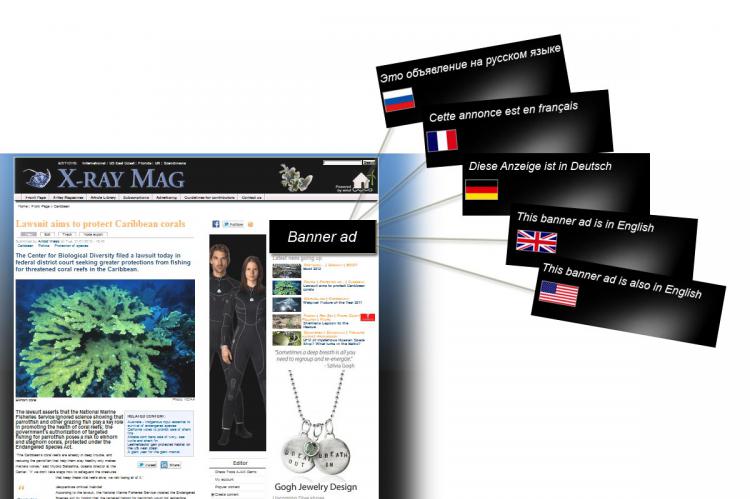Geo-targeting is included. But what is it?
In short, geo-targeting is a feature that enables our website to display different versions of your banner ads to different segments of the audience. For example, a version worded in German can displayed for visitors from Germany, or two different versions in English can be displayed in the UK and the US, respectively.
Geo-targeting is an option that is included in our package deals at no extra cost.
Wikipedia writes:
Geo-targeting in geomarketing and internet marketing is the method of determining the geolocation of a website visitor and delivering different content to that visitor based on his or her location, such as country, region/state, city, metro code/zip code, organization, IP address, ISP or other criteria.
A common usage of geo-targeting is found in online advertising, as well as internet television with sites such as iPlayer and Hulu restricting content to those geolocated in specific countries (also known as digital rights management). Use of proxy servers and virtual private networks may give a false location.
Uses
The most obvious use of the geo-targeting option is to have different versions of your ad presented in various languages, as mentioned in the introduction above. The banner ad serving software can even differentiate between, say, French-speaking and English-speaking Canadians; and in the US, the geographic resolution can be broken down to city level. Even if you only have one language or version of the ad, you can still make good use of this feature, say, if you have regional distributors to whom you want to direct local inquiries. In other words, while the ads may be identical, we can link them to different destinations.
Different currencies
Another popular use is to have one banner with prices in USD being served in North America and a version with rates in Euros being served in Europe,
What is required?
- All ads should be of the same size and format.
- All ads should be delivered together so we can upload them in one work process
Advanced users: Additional delivery options
Client - IP address: Allows the ad to be targeted to users coming from specific IPs (or blocks of IP addresses).
Client - Domain: Target an ad to users coming from a specific domain (NB: This domain is obtained by a reverse DNS lookup of the user's IP address).
Client - Useragent: This will enable you to target ads to matching strings, which includes information about the user's browser/operating system.
Site - Channel: You must first set up at least one channel to target by channel (or section) of a website.
Site - Page URL: This will result in the ad displaying on selected page(s) in your site only.
Site - Referring Page: Select this option to show an ad to on pages linked to from the selected page(s).
Site - Variable: Targeting in this manner will result in an ad being delivered to any ad request containing a specific variable. These variables can be any value passed in the HTTP request, e.g. to limit by gender=male or by a numeric variable, such as age 18 and over.
Site - Source: The Site:Source targeting is similar to the Site - Variable, except it targets ads against the passed in "source=" value only.
Time - Date: Target an ad to appear on a specific date of the month or year.
Time - Day of Week: Your ad will appear only on a particular day or days of the week.
Time - Hour of Day: Target times when visitors are more likely to respond to the ads being delivered, e.g. a breakfast snack ad in the morning.





























